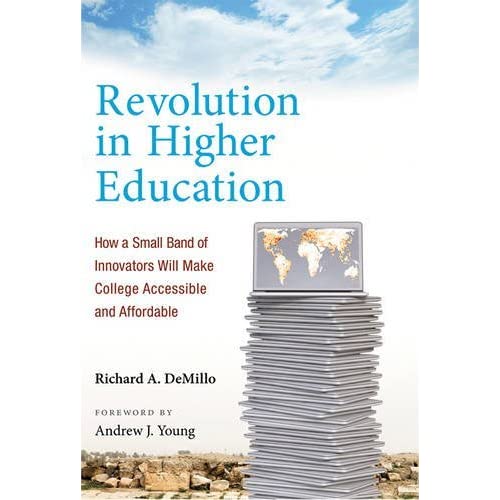In 2012, I reviewed Rich DeMillo’s book Abelard to Apple: The Fate of American Colleges and Universities. Abelard was about the value of higher education and how institutions in the middle (below elite and above the low-cost institutions with a business model to serve many students) must evolve or perish.
In Revolution, Dr. DeMillo continues where he left off with Abelard, noting that “most American colleges and universities are locked in a system that is anything but excellent.” The “Middle” represents the 4,000 colleges and universities just below the elite level, the ones that are “in trouble.” The Middle schools enroll 80 percent of all students, are in financial disrepair and their historical inability to control costs has reduced public confidence in the value of a college degree. Without innovation, cost increases at institutions will continue to repel prospective students.
Part I, the Revolution, describes what the innovators are attempting to change. According to DeMillo, the Revolution began when Sebastian Thrun announced that he was leaving Stanford to start Udacity. Affordable quality is one goal of the Revolution, and is achieved by unbundling university services to deliver only those that students value at a lower cost than the traditional model. Improved classroom productivity success means that education will deliver successfully at scale and reduce the number of professors required. This will require new types of institutions.
Part II explains what the Revolution aims to change — the hierarchy of elites built into the culture of higher education that stifles true innovation and encourages the continuing escalation of costs. Quality higher education is rapidly becoming inaccessible, according to DeMillo, and policymakers and the public are misinformed about what is causing the rapid rise in tuition. Reformers are focused on utilizing technology to allow them to unbundle services and lower costs. Elite envy has influenced strategy and reduced colleges’ ability to meet student needs.
The Revolution has encountered opposition and will continue to do so from many fronts. Part III discusses the difficulty of destroying university brands and whether or not online education can be branded at the same high level as elite education. Innovation threatens tenure, even though the percentage of faculty with tenure is at an all-time low. The same technology that can be used to innovate higher education is used by those resisting innovation to polarize institutions and communities.
The last part explores the compact between society and universities. Successful innovators will have to persuade their students that education has value and values. Governments will have to embrace the idea of combining both value and values. DeMillo applauds the heroes of the Revolution, noting that there will be heroes and martyrs along the way. The martyrs may launch ideas that fail due to economics, politics, the changing tastes of the public or some combination thereof.
It’s unfortunate that the author didn’t cover more companies/institutions that have innovated, particularly from a value/cost perspective. However, those that are included are fairly representative of many others not mentioned. His ideas of scale in instruction exceed any that I have ever read. In Chapter Five, he explains “The Scaling Problem” by stating that “one professor, teaching several large lectures, even with the help of a small army of teaching assistants, can touch at most a thousand students at a time.” Because of increasing labor costs, he states “a single professor must be able to touch tens of thousands of students at a time.”
While I believe that the student/faculty ratio at many institutions can be improved through technology, we nonetheless have to continuously improve course designs to achieve better ratios for students of all learning abilities. To that point, DeMillo states that only two additional faculty members were hired to manage an increase of nearly 9,000 students enrolled in Georgia Tech’s online master’s degree in computer science. While that’s clearly improved efficiency, students admitted to the online program had to meet the same high admissions standards as the traditional program and are likely superior students compared to the average student.
Marketing is another area impacting efficiency and costs that is not discussed in the book. Student acquisition costs are expensive for most colleges and increasing enrollment to levels seldom experienced may be an expense Dr. DeMillo has not considered. Lastly, the author covers some of the cultural issues that can block these efficiencies from being implemented by members of the academy but does not examine the regulatory environment that has stifled innovation at accredited institutions.
I recommend Revolution in Higher Education to anyone involved in higher education. It’s thought-provoking and covers many of the issues involved with innovation.











